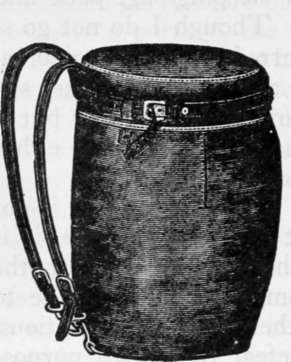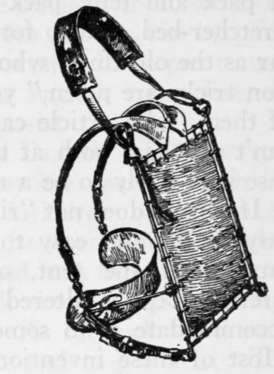Packs For Pedestrians. Part 5
Description
This section is from the book "Camping And Woodcraft", by Horace Kephart. Also available from Amazon: Camping and Woodcraft.
Packs For Pedestrians. Part 5

Fig. 34. Pack Basket (covered).

Fig. 35. Abercrombie Pack Frame.
To my notion, the best that can be said of the pack basket is that it is a bully thing in which to carry canned and bottled goods—when some other fellow does the toting. It is too heavy, too abrasive, and too bothersome in the brush and thickets, for average foot travelers, and it does not stow so well in a canoe as a pack sack of equal capacity.
Pack Frames
The far Northwest has another pet rig for the "human beast of burden": the pack frame. In its simplest form this consists of two vertical or slightly flaring pieces of wood joined by cross-bars near the top and bottom, covered with a sheet of canvas, and fitted on one side with broad straps for the shoulders, on the other with straps, ropes, or thongs, for tying on the load. One model has a little skeleton shelf on the back, near the bottom, for the pack to rest on, this shelf being fitted with hinged metal supports so it can be folded down when not in use. Such a frame leaves an air space between the body and the pack, and so does not sweat the carrier's back like a knapsack. A load of any size or shape can easily be fixed on it. The weight is comfortably balanced and divided between shoulders and hips. The upright pieces of wood are of such length that their lower ends support the whole load when the man sits down to rest, as on a log, for instance.
Figure 35 shows a new invention in pack frames, by D. T. Abercrombie. In this the frame, and consequently the load, is kept quite away from the lower part of the back, being joined to a hip strap by a rod with horizontal arm on each side. There is a tump strap, as well as shoulder straps. Heavy weights can be carried with this contrivance, and, no matter how hard or irregular the load may be, it cannot hurt the back. The frame complete weighs only 2 1/2 pounds.
Pack frames are not suitable for ordinary pedestrian trips, of course, but have such merit lor portaging heavy and hard or sharp-cornered baggage that I mention them here, while on the subject of packing on human backs and shoulders.
Canteens
One may travel where water is hard to find, though this seldom is the case in a timbered region. The best canteen is one of aluminum, which neither leaks nor rusts like the old-fashioned tin affairs. It should have a canvas cover with felt lining. When the felt is wet its moisture cools the water in the canteen bv evaporation. The canvas cover prevents too rapid evaporation, and keeps the canteen from wetting one's clothing. At night, or in case of illness, the thing can be used as a hot-water bottle, the insulation keeping the water hot for a considerable time. The best pattern is the present regulation army canteen, which is shaped like a flat flask, but with one side rounded a little and the other concaved to fit the body. It has a flat bottom, so you can stand it up. The aluminum screw-cap, held by a chain, cannot jolt out like the corks of common canteens.
To cleanse the vessel, boil it. To sterilize suspected water, fill the naked canteen and place it, unstoppered, on the fire till the water boils. The army model holds one quart, and weighs 11 ounces. It can be bought from some outfitters, either with or without an aluminum cup that fits over the bottom. It is rigged to carry on the belt, where it will not flop nor pound the wearer. To draw it from its cover, turn two little thumb-screw fasteners half a turn, and you can whisk it out almost as easily as you would a pistol.
Aluminum is not fit to carry liquor in; but, for that matter, neither is tin. One of my old partners and I, on a voyage to the Arkansas swamps, once hit upon what we conceived to be a brilliant scheme for transporting a gallon of whiskey inconspicuously in our John-boat. (You know whiskey warms the hearts of otherwise disobliging natives—yes in-deedy). We got a new kerosene can, had a tinner remove the spout and solder a patch of tin over it; then in went Old Taylor. We didn't open that can for a week (hadn't seen any natives). Then along came the dickens of a cold rain, and, when it ceased, we declared an "emergency." Well, what do you think? That whiskey had turned as black as ink. Potztausend himmel donnerwetter! or words to that effect. If anybody doubts that we didn't open that stuff for a week, I refer him to S. D. Barnes, captain of said John-boat, of which I was crew.
In mountaineering it often happens that one olans to camp on or near the summit, and wants to carry water with him from some head spring, to save a long climb down after it. A large canteen would be cumbersome. A half-gallon rubber water-bottle solves the problem. It weighs less than a pound, and takes up little room in the pack. In cold weather, such a bottle, filled with hot water, may save packing the weight and bulk of an extra blanket.
Continue to:
- prev: Packs For Pedestrians. Part 4
- Table of Contents
- next: Chapter IX. How To Walk. A Hunter's Pack. Going Alone
